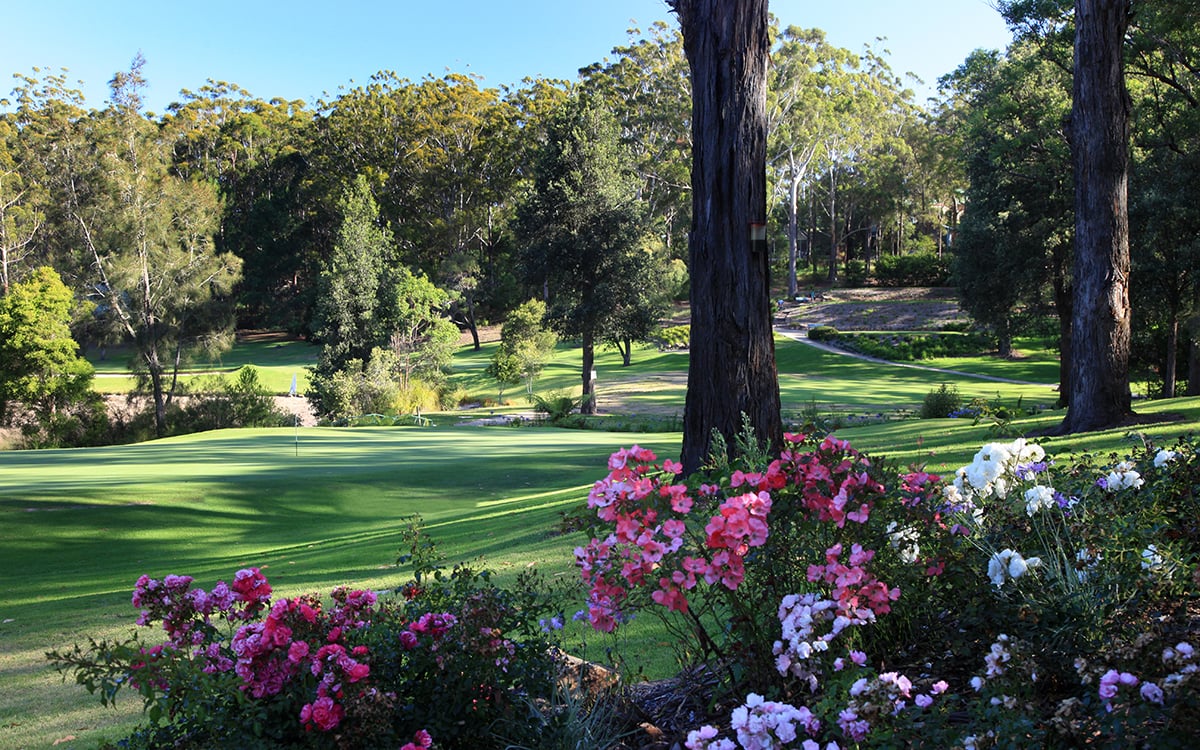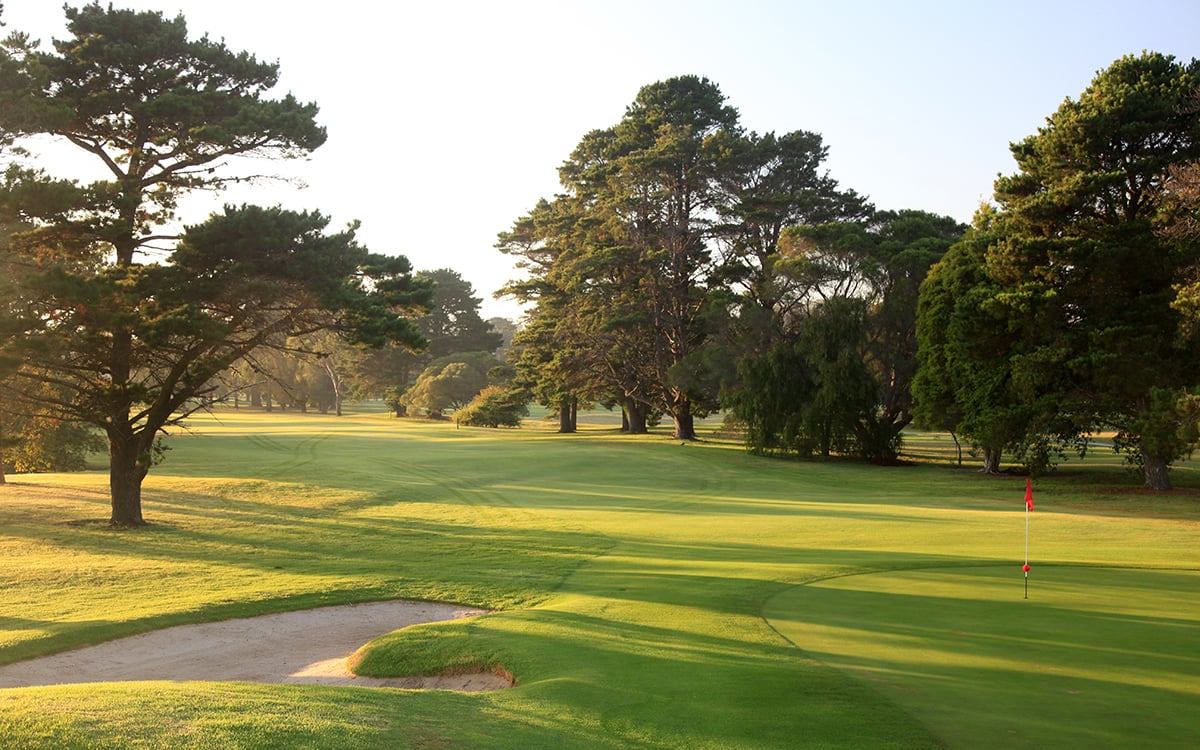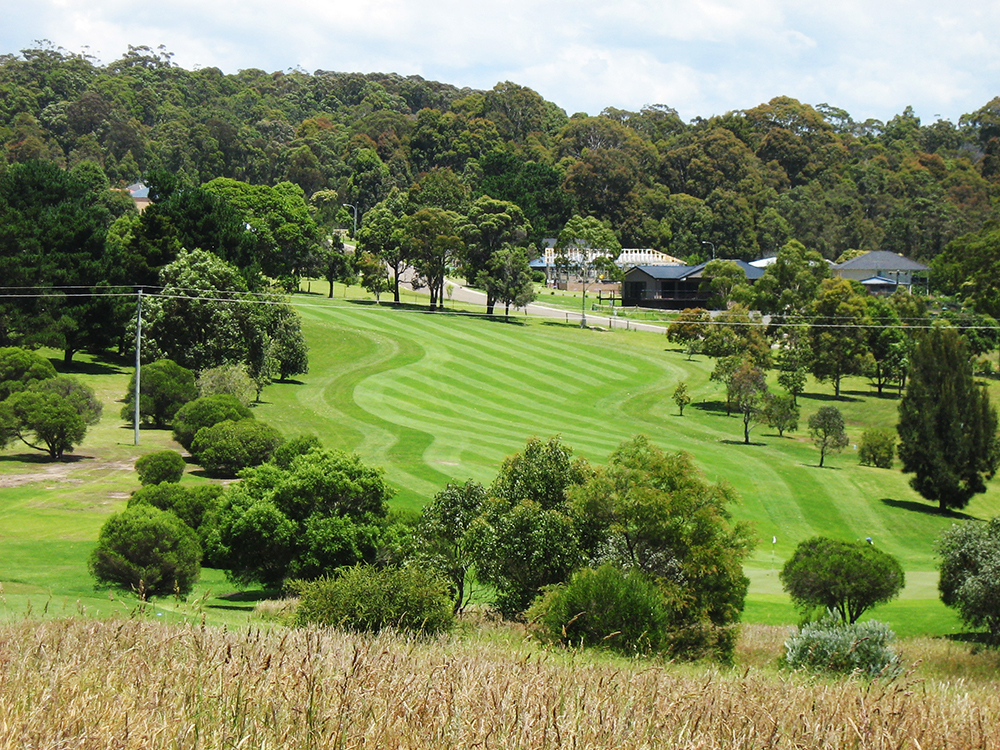CALL me biased, as someone who’s never resided in any other state than New South Wales, but it might be the most geographically and climatically diverse government-delineated place on the planet. Where else offers beach, desert, outback, alpine, rainforest, mountain, coastal, urban and rural landscapes all without traversing a border?
While the part of the state painted with the broad-brush term South Coast can’t offer some of those natural features, it does unite several of those assets in an exceptional stretch of coastline stretching – depending on your definition – from the Illawarra to the Victorian border. The seaside areas highlight some of the most dramatic meetings of land and sea in the country, contrasted by mountains and escarpments as a backdrop and snowfields perched not much farther beyond. In an area of great diversity, the south-eastern corner is the lone part of Australia’s original state to combine snow and sea.
For golfers, a series of famous and not-so-famous courses line this coastal expanse with most of the go-to layouts conveniently dotted every 75 kilometres or so along the journey south to Eden. Narooma Golf Club is the best-known stop, thanks largely to its clifftop setting and the Paul Hogan commercial shot in the water far below the third green. Narooma battles Mollymook’s Hilltop course for the right to be called the South Coast’s ‘best’ course but for visitors it’s a moot point as you’d be mad not to play both.

Deep South
As any tour of the region should, my most recent visit began with a journey along Grand Pacific Drive, including the stunning Sea Cliff Bridge that’s perched above the crashing waves of the Pacific Ocean. As a prelude to the rest of the coastline, taking this route to Wollongong and beyond is about as good as previews get.
Golf will never be a walk in the park figuratively, but it absolutely should be in a literal sense. Tucked away in a secluded part of Albion Park, Calderwood Valley Golf Course is a golf course like few others. The former horse farm is blessed with gently undulating land set against the impressive Illawarra escarpment. The land was turned over to golf in 1995 but in many ways the game has fit the landscape for far longer.
Social golf rules at Calderwood. There are no members and as such it is a golf course as opposed to a golf club, which means full access – even in peak times – for social golfers. And they come in droves. It is not unusual for social groups to book as far as five or six years in advance in order to secure a block of tee-times.
Calderwood is a fun, friendly and relaxed golf venue. The par-70 layout measures just a tick longer than 5,000 metres and is expansive enough to keep novice golfers happy while challenging the better player more often than not. A recently completed drainage program has the course in peak shape, while a sprinkling of new bunkers on the par 5s has bolstered the test. Arguably the toughest hole is the 11th, a 174-metre par 3 with a water carry and a bank fronting the green that wants to send balls down towards the hazard. Earlier, the 148-metre sixth is another short hole but this time set in its own enclosed little ecosystem in the corner of the property.
One thing to look out for at Calderwood: beside the 16th tee is a sizeable avocado tree that, in season, bears fruit in abundance. Golfers are welcome to pocket a few.

Nearer to the coast, Kiama Golf Club is a sand-based course built on a narrow strip of land that’s cut in two by a road. Once a relatively barren site, several decades ago the club planted a series of pine trees across the course that turned it into a tree-lined haven. Gradually these pines are dying off, to be replaced by natives. Meanwhile, the canopies of the pine trees have the effect of narrowing the chutes off several tees.
Eight short holes within the par-66 layout place a premium on strong iron play, an attribute further highlighted by the small, deep greenside bunkers – many with flashed-up faces that peer at you back in the fairway. Avoiding these pots on approach shots is a key to navigating the course. Kiama is a tougher test than it first looks. That’s certainly what PGA Legends Tour players discovered during their pro-ams the past two Octobers. A winning score of even-par took the trophy last year after many in the field thought they’d eat it up based on their practice rounds.
The course is mostly flat, save for the downhill opening tee shot and substantially uphill climb to the par-3 ninth green. The most strategic hole is the 10th, a par 4 of just 275 metres from the back tees. A pond fronting the green eats into the right side of the fairway, making even cautious lay-ups from the tee a wide-eyed moment. Golfers with visions of driving the green not only need to fly their tee shot 260 metres or more, they need to be straight. In the town known for its famous blowhole, this is one hole you most definitely don’t want to blow up on.
Kiama is a hub for the local community as well as the golf-playing population. Clubhouse renovations in recent years have created a pleasant ambiance above the opening and closing holes of both nines, with plans to continue the facelift.

Hugging the coast road south takes you to Gerringong Golf Club, which occupies one of the most underrated pieces of land for golf along the state’s entire coastline. With ocean views on every hole, the wide-open course is exposed to any seaside breeze as it dips and turns with the dramatic landform. The club promises a round that lives in memory for years afterwards and it’s difficult to argue otherwise. Bypass it and you’ve missed a truly special spot.
The golf on offer ramps up a notch as you venture further south past Jervis Bay to the beachy locale of Mollymook. Attached to the better-known town of Ulladulla, Mollymook Golf Club is home to 27 holes in two locations: the 18-hole Hilltop and the more sedate but scenic nine-hole Beachside course on the edge of Mollymook Beach.

These days the courses are managed by Troon Golf and the Hilltop is partway through a substantial renovation project that began two years ago at the hands of Mollymook’s course maintenance contractor, Programmed Turnpoint, and is part of a broader 15-year course upgrade plan. The bunkers were the initial focus as many were removed, replaced or rebuilt and others added. Steps to come include the reshaping of green complexes, additional tees and the rebuilding or levelling of others – all with minimal disruption to the layout.
The course is in outstanding condition and the back nine is one of the prettiest and most challenging stretches of holes around. The elevation changes – some quite severe – link with a forest and garden-like setting to provide tranquility. Tranquil, though, is hardly the word to describe the greens. There are some brutal contours to the Hilltop course’s shortest grass. We hear the advice, “Stay below the hole” often but on these putting surfaces it often is mandatory. The club itself puts it best with this succinct warning: “Once on the putting surface there may still be a good deal of golf left.”
The green at the 13th – a gorgeous, over-a-hill par 5 to a target set just beyond a creek – defines diabolical. At the 2015 NSW/ACT PGA Senior Championship, the foursome of Terry Price, Mike Harwood, Peter O’Malley and Richard Backwell were seeded together for the last round and of the quartet only Price didn’t four-putt the 13th. It’s the sort of green where being out of position can have you turning your back on the cup for a 15-footer and praying you’ve selected the right line. Director of golf Barry West quips that the winner of each Senior PGA event held at Mollymook has offered to donate their time for free to rebuild the 13th green due to the nightmares it causes.
The front nine at Hilltop is solid but the back nine is where the blood starts pumping with a series of enticing approach shots into the greens. About the only thing the course lacks is a show-stopping 18th hole to match the eight before it. The 452-metre par 5 climbs straight uphill and is a tough slog back to the clubhouse, although the addition of two new fairway bunkers in the upgrade will improve the closer.

One of the staples of South Coast golf is Catalina Country Club in the seaside haven of Batemans Bay, another 27-holer in remarkable condition. Catalina’s professional Mal Wilson tells a story of when his longtime friend Rodger Davis contested the PGA Legends event at the club. The 1986 Australian Open champion declared the greens were more consistently true than anything he encountered in his successful stint on the Champions Tour in America.
The distinguishing feature of Catalina’s three nines is that none is noticeably superior to the other. In other words, no matter which combination of 18 holes you play, golfers are in for a treat. The 19-27 loop is marginally shorter but that’s about the only discernable difference. There are highlights throughout, although the cute but menacing 14th hole, a 137-metre par 3 where the green juts into a lake, is often a talking point in the clubhouse afterwards.

Double Act
There can be no discussion about South Coast golf without mentioning Narooma Golf Club. The course holds ‘must-play’ status along this part of the Pacific and remains as popular as ever. Like much of the coast, the town is perfectly poised to draw golfers from Australia’s two largest cities plus the nation’s capital. But it’s a place well supported by regional centres like Wagga Wagga and Albury, too. Basically, everyone who can get to Narooma does.
Famous for “Hogan’s Hole”, the par-3 third that was the scene of the aforementioned Paul Hogan television commercial in the 1970s, Narooma is a course of two halves. The first seven and last two holes sit upon open, clifftop land set above the crashing waves of the ocean below. Comparatively, holes eight to 16 might as well be in another state – sloping, heavily wooded holes in complete contrast to the rest. Where the seaside set offers the style, the inland holes provide the substance in what is one of the best examples of setting diversity within one golf course in Australia. Some judicious tree clearing on the back nine in recent years has opened up vistas of the lake, further enhancing its best assets.
The 137-metre third is truly iconic and a fabulous place to fire a short iron across a gaping chasm in the coastline to a green on the other side, but I’ve always liked the second hole just a little bit more. From a tee set at the highest point on the course, you fire a drive into the hillside far below before climbing to the green set against the cliffs and two bunkers. Last time I played the second, I hit what I thought was a pretty good 7-iron up the hill but never saw the ball again. Whether it sailed long or was short enough to be swallowed by the sea, I still don’t know. A few years ago, some photos of the second green gained traction on social media after lightning struck the flagstick, creating scorch marks across the putting surface. Maybe it was someone from above returning my lost ball…
Narooma general manager Dominic Connaughton says these days the 15th hole generates as much player comment as the much-vaunted third. It is the best of the back nine, a 331-metre par 4 benched tight against the lake that is the centrepiece of that half of the course. Drives struck from a tee set back into the bushland need to carry an inlet in the lake before finding a strip of safe ground on the other side. Tee shots hugging the more dangerous left side do open up the angle to some pin positions but, intriguingly, often the opposite half of the fairway will be optimal as the green is cloverleaf in shape with three distinct lobes. A gaping front bunker provides further defence.

Where the South Coast blends with the northern edge of the Sapphire Coast is the fishing town of Bermagui, which enjoyed its moment in the sun as the site of the 2001 Billy Connelly and Judy Davis movie, “The Man Who Sued God”. Why Bermagui? It was director Mark Joffe’s favourite holiday spot, which helped the town get the nod over Pittwater in Sydney’s north.
Neither divine intervention nor litigation is required to decipher Bermagui Country Club, although the layout is far more multi-dimensional than first impressions reveal. Longtime pro Chris Hearn tells a story about an experienced, well-travelled amateur golfer who ventured into the club’s carpark once only to turn around and drive straight back out. About 18 months later, the same golfer returned to compete in a tournament there and afterwards shared the story of his earlier truncated visit that gave him no clue as to how good the course is.
Hearn says there is a certain mystique to the Bermagui course, as the entry, carpark and clubhouse precinct doesn’t reveal much. The first, ninth, 10th and 18th holes occupy low-lying tidal flats and, while interesting and challenging enough, don’t own the compelling topography of the other 14 holes. The course has hosted multiple state events in recent years and its pro-am is gaining in following to the point that it’s now a two-day event – always a good measure of a tournament’s popularity and prosperity.
It’s easy to trip up from the start at ‘Bermy’, as the opening drive needs to navigate a ball-swallowing wetlands area clinging to the right edge of the first fairway plus a creek cutting across the short grass before the uphill climb to the green. Bermagui’s first hole carries the No.1 index for a reason, even though it’s a 391-metre par 4. Further on, many of the members know the seventh is a hole to respect, a 387-metre two-shotter with another uphill approach and a creek to the right. The best hole might be the 14th, a down-then-up par 4 of 335 metres where the same creek splits the fairway, forcing either an aggressive drive over the hazard or a well-placed lay-up then uphill second.
And there’s no need to stop this golf escapade there. Journeying farther south, the courses of Tathra, Merimbula, Eden and beyond complete a scintillating run of golf in New South Wales’ most eclectic corner.
Bermagui Country Club
Tuross St, Bermagui NSW
(02) 6493 4461
Green fee: $36
www.bermaguicountryclub.com
Calderwood Valley Golf Course
Calderwood Rd, Calderwood NSW
(02) 4256 3055
Green fees: $22-$28
www.calderwoodgolf.com.au
Catalina Country Club
Beach Rd, Catalina NSW
(02) 4472 4386
Green fee: $40
www.clubcatalina.com.au
Gerringong Golf Club
Crooked River Rd, Gerringong NSW
(02) 4234 3333
Green fee: $32
www.gerringonggolf.com.au
Kiama Golf Club
Oxley Ave, Kiama Downs NSW
(02) 4237 7339
Green fee: $34
www.kiamagolfclub.com.au
Mollymook Golf Club
Beachside course: Golf Ave, Mollymook NSW
(02) 4455 1911
Hilltop course: Clifford Close, Mollymook NSW
(02) 4455 2055
Green fees: $19-$25 (Beachside, nine holes); $49-$59 (Hilltop)
www.mollymookgolf.com.au
Narooma Golf Club
Ballingalla St, Narooma NSW
(02) 4476 0507
Green fee: $55
www.naroomagolf.com.au




